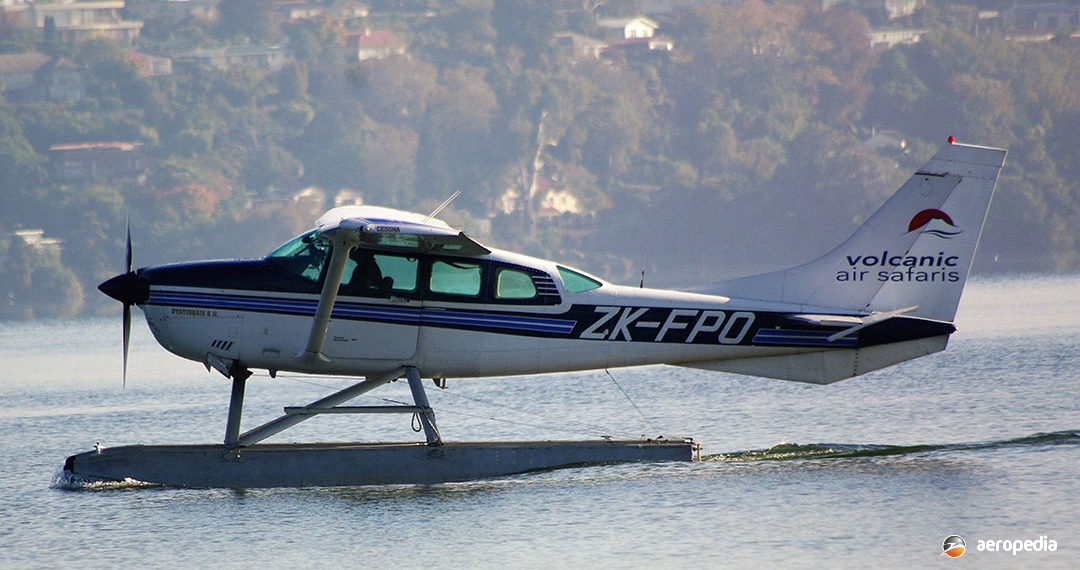Photograph:
Cessna U206G ZK-FPO (c/n U20605772) at Rotorua, NZ in April 2012 (David C Eyre)
Country of origin:
United States of America
Description:
Light utility aircraft
Power Plant:
One 224 kw (300 hp) Teledyne Continental IO-520-F six-cylinder horizontally-opposed air-cooled engine
Specifications:
- Wingspan: 10.92 m (35 ft 10 in)
- Length: 8.61 m (28 ft 3 in)
- Height: 2.83 m (9 ft 3½ in)
- Wing area: 16.2 m² (174 sq ft)
- Max speed at sea level: 289 km/h (179 mph)
- Cruising speed at 1,981 km/h (6,500 ft): 272 km/h (169 mph)
- Rate of climb at sea level: 280 m/min (920 ft/min)
- Service ceiling: 4,511 m (14,800 ft)
- Range at 272 km/h (169 mph) at 1,981 m (6,500 ft): 1,343 km (834 miles)
- Max range at 3,048 m (10,000 ft): 1,667 km (1,036 miles)
- Empty weight: 870 kg (1,919 lb)
- Loaded weight: 1,633 kg (3,600 lb)
History:
The Cessna 205 was a derivative of the Model 210 fitted with a fixed undercarriage and increased passenger capacity. From the Model 205, of which only a small number were built by Cessna standards, the Model 206 was evolved. The Model 205 was then dropped from the production line.
The Model 206 was offered in three variants when it first appeared in 1964: the U206 Super Skywagon, the P206 Utility, and the P206 Super Skylane. All three were powered by a 213 kw (285 hp) Continental engine. The Super Skywagon featured conical-camber wing tips, a tailplane of greater span, larger flaps, and double cargo doors for ease of loading. The Utility had the usual passenger door, and the Super Skylane was a deluxe six-seat version with passenger doors on both sides in the front, and a third door on the rear port side.
In 1966 all three variants were available with the option of a turbocharged engine and, by 1968, the power had been increased to 224 kw (300 hp). By this time also the turbo-system Super Skywagon appeared, providing a service ceiling of 8,016 m (26,300 ft). To take advantage of this performance, a 4.24 m³ (76 cub ft) oxygen unit, including a pilot’s mask with built-in microphone and passenger masks, etc, was made available as an option.
In 1971 the Model 206 series was replaced in the Cessna range by the Stationair and Turbo Stationair in order to distinguish between these aircraft and the 180 and 185 series. The 213 kw (285 hp) Continental engines were retained as standard, and all Stationairs were fitted with double cargo doors on the starboard side. Although rated at 213 kw (285 hp), the Continental engine delivered up to 224 kw (300 hp) for take-off.
In 1977 the turbocharged engine was refined to give its maximum power at 100 rpm less, thus permitting power to be increased to 231 kw (310 hp). In 1978 the Stationair 6 and Turbo Stationair 6 were introduced to the production line, replacing the Model 206 and Turbo Stationair. In 1979 production continued, with the only change being an increase in fuel capacity to 348 litres (76 Imp gals). In 1980 anti-icing was made available as an option, to be incorporated in the propeller, windshield, pitot tube and stall warning.
This series proved very popular for utility work in this region. A number have operated as floatplanes and amphibians in Australia, New Zealand, and Pacific islands on tourist flights. At the time when production of the series ceased in 1985 some 7,556 examples had been built. At around that time the production models were the Stationair 6 and Turbo Stationair 6, the latter having a 231 kw (310 hp) Continental TSIO-520-M turbo-charged engine.
In the late 1990s the Cessna 206 series was returned to production, the new models being the normally aspirated 206H and the turbocharged T-206H, known as the Turbo Stationair. The first of the new models flew on 6 August 1996 powered by a Lycoming TIO-580 engine; but Cessna decided to install the Lycoming IO-540 and TIO-540 series of engines in the new production model.
Seating six, the Stationair had double cargo doors, a 5.15 m³ (182 cub ft) 650 kg (1,432 lb) useful load and, like the Turbo Stationair, had a range of options including utility or luxury interiors, electric propeller anti-icing system and cargo pod. It could be fitted with oversize tyres or floats, and was available with the Garmin G1000 state-of-the-art avionics display.
The Stationair could cruise at 263 km/h (163 mph) and the Turbo Stationair could cruise at 330 km/h (205 mph), climb at 320 m/min (1,050 ft/min), reach 8,230 m (27,000 ft), had a range of 1,302 km (703 miles) with full fuel, and had a six-place oxygen system as standard.
More than 180 examples of the Cessna 206 series have been registered in Australia, and 47 in New Zealand. During 2005 a total of 112 new aircraft was delivered and production still continued in 2015.
Like many other types, the Cessna 206 series has also been improved by other companies to enhance performance, one example of this being T-206G Stationair VH-CZR (c/n U206-0653) being fitted with an Allison 250 turboprop which operated on skydiving duties.
A number of Australian registered Cessna 206s were cancelled from the register in later years, six of these being registered in Bolivia, VH-OBP (c/n U20606759) becoming CP-3051, VH-JEK (c/n U20606774) becoming CP-3009, VH-PJY (c/n U20605120) becoming CP-3043, VH-UFG (c/n U20604607) becoming CP-3012, VH-FBT (c/n U20605011) becoming CP-3032 and VH-TUD (c/n U20602445) becoming CP-3032.

